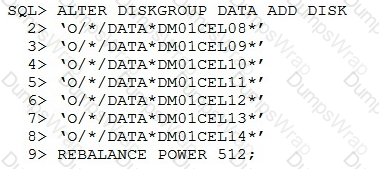Oracle Exadata Database Machine X9M Implementation Essentials Questions and Answers
Which two statements are true about the IPTables firewall configuration on a new Exadata Database Machine after initial deployment?
Which two of the following network connection types can be deployed on the client network ports of an Exadata X9M-2 Database Server?
Examine these commands:
1. Execute "crscti stop cluster -all" as the grid user from one database server.
2. Execute "crscti stop cluster -all" as root from one database server.
3. Power off all network switches.
4. Execute "crscti stop cluster" as root from one database server.
5. Execute "crscti stop cluster" as the grid user from one database server.
6. Power off the rack using the power switches on the PDUs.
7. Execute "shutdown -h now" on all database servers.
8. Execute "shutdown -h now" on all Exadata storage servers.
Which is the correct order or the required commands to completely power off an Exadata Database Machine in an orderly fashion?
Which two options describe the flash memory capabilities of the Exadata X9M-2 database and storage severs?
You are providing oversight for the delivery of a new Exadata Database Machine.
1. Stabilize the Exadata Rack.
2. Unpack Oracle Exadata Rack.
3. Review the safety guidelines.
4. Let the Exadata acclimatize for 24 hours.
5. Power on Exadata PDU A.
6. Place Exadata in its allocated space.
7. Power on Exadata PDU B.
What is the correct order of these steps?
An Exadata storage server physical disk on an X9M-2 high-capacity full rack entered the predictive failure state. Which two steps must you perform to replace this failed physical disk?
Which three component faults are covered by Oracle Auto Service Request (ASR)?
You have been asked to investigate why an Exadata Database Server stopped communicating on the client network for 10 minutes over the past weekend.
Which command would help investigate this?
For which four component failures on an X9M Database Machine does Auto Service Request (ASR) raise service requests?
Which two statements are true about applying updates on Exadata systems?
What is the minimum Exadata System Software version required for Exadata X9M?
You use Enterprise Manager to monitor all the components of your Exadata Database Machine.
Recently, you discovered that certain asmdisks were offline in one of the diskgroups used by the rac database called prod.
In which two sources would you find diagnostic messages related to this problem?
Which two Exadata security features would you configure to control which databases can access which griddisks, when multiple databases share space on your storage servers in an unpartitioned storage grid?
Which two statements are true about Auto Service Request (ASR) with an Exadata Database Machine?
You are in the process of upgrading your nonvirtualized X9M-2 Database Machine elastic configuration with 4 database servers and 7 HC storage servers with an additional 4 database servers and 7 HC storage servers.
The new storage servers are called DM01CEL08 through dmoicel14.
After creating 96 new griddisks, you issued this SQL statement:

How many failgroups if any, will be added to the DATE diskgroup by executing this SQL statement?
Which two quarantine types can disable Smart Scan for multiple databases that offload SQL statements to a cell on an Exadata Database Machine?
Which two statements are true about the types of Exadata X9M-2 storage servers: the High Capacity (HC) storage server, the Extreme Flash (EF) storage server and the Extended server?
You have been tasked with replacing a memory module of an Exadata Storage Server and need to power off the affected storage server. Which two commands must you execute to safely power off the storage server in an Exadata X9M Database Machine?
You want to monitor how a large production table is accessed. Especially, you are interested to see how the access on that particular table leverages the benefits of the Exadata Platform.
Which two actions are NOT appropriate for that purpose?
What is the maximum DRAM capacity you can expand an X9M-2 DB Server?
Which three statements are true concerning the configuration or use of Enterprise Manager Cloud Control to monitor and manage Exadata Database Machine components?
Which of the following is NOT a requirement when validating, receiving, unpacking, and planning access route and space requirements for Exadata Database Machine?
Which three statements are true about the Grid Infrastructure configuration after a nonvirtual deployment of a new Exadata Database Machine with a single cluster?
You have a script with several CELLCLI commands that must be executed on each cell in your Exadata full rack. The script must run on each cell simultaneously. How must you achieve this?
Which two statements are correct about adding an additional database server to a physical Exadata X9M Database Machine using Oracle Exadata Deployment Assistant (OEDA)?

